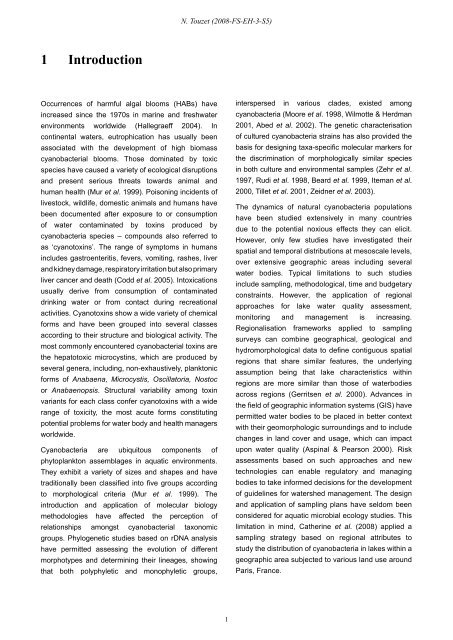STRIVE - Environmental Protection Agency
STRIVE - Environmental Protection Agency
STRIVE - Environmental Protection Agency
You also want an ePaper? Increase the reach of your titles
YUMPU automatically turns print PDFs into web optimized ePapers that Google loves.
1 Introduction<br />
Occurrences of harmful algal blooms (HABs) have<br />
increased since the 1970s in marine and freshwater<br />
environments worldwide (Hallegraeff 2004). In<br />
continental waters, eutrophication has usually been<br />
associated with the development of high biomass<br />
cyanobacterial blooms. Those dominated by toxic<br />
species have caused a variety of ecological disruptions<br />
and present serious threats towards animal and<br />
human health (Mur et al. 1999). Poisoning incidents of<br />
livestock, wildlife, domestic animals and humans have<br />
been documented after exposure to or consumption<br />
of water contaminated by toxins produced by<br />
cyanobacteria species – compounds also referred to<br />
as ‘cyanotoxins’. The range of symptoms in humans<br />
includes gastroenteritis, fevers, vomiting, rashes, liver<br />
and kidney damage, respiratory irritation but also primary<br />
liver cancer and death (Codd et al. 2005). Intoxications<br />
usually derive from consumption of contaminated<br />
drinking water or from contact during recreational<br />
activities. Cyanotoxins show a wide variety of chemical<br />
forms and have been grouped into several classes<br />
according to their structure and biological activity. The<br />
most commonly encountered cyanobacterial toxins are<br />
the hepatotoxic microcystins, which are produced by<br />
several genera, including, non-exhaustively, planktonic<br />
forms of Anabaena, Microcystis, Oscillatoria, Nostoc<br />
or Anabaenopsis. Structural variability among toxin<br />
variants for each class confer cyanotoxins with a wide<br />
range of toxicity, the most acute forms constituting<br />
potential problems for water body and health managers<br />
worldwide.<br />
Cyanobacteria are ubiquitous components of<br />
phytoplankton assemblages in aquatic environments.<br />
They exhibit a variety of sizes and shapes and have<br />
traditionally been classified into five groups according<br />
to morphological criteria (Mur et al. 1999). The<br />
introduction and application of molecular biology<br />
methodologies have affected the perception of<br />
relationships amongst cyanobacterial taxonomic<br />
groups. Phylogenetic studies based on rDNA analysis<br />
have permitted assessing the evolution of different<br />
morphotypes and determining their lineages, showing<br />
that both polyphyletic and monophyletic groups,<br />
N. Touzet (2008-FS-EH-3-S5)<br />
1<br />
interspersed in various clades, existed among<br />
cyanobacteria (Moore et al. 1998, Wilmotte & Herdman<br />
2001, Abed et al. 2002). The genetic characterisation<br />
of cultured cyanobacteria strains has also provided the<br />
basis for designing taxa-specific molecular markers for<br />
the discrimination of morphologically similar species<br />
in both culture and environmental samples (Zehr et al.<br />
1997, Rudi et al. 1998, Beard et al. 1999, Iteman et al.<br />
2000, Tillet et al. 2001, Zeidner et al. 2003).<br />
The dynamics of natural cyanobacteria populations<br />
have been studied extensively in many countries<br />
due to the potential noxious effects they can elicit.<br />
However, only few studies have investigated their<br />
spatial and temporal distributions at mesoscale levels,<br />
over extensive geographic areas including several<br />
water bodies. Typical limitations to such studies<br />
include sampling, methodological, time and budgetary<br />
constraints. However, the application of regional<br />
approaches for lake water quality assessment,<br />
monitoring and management is increasing.<br />
Regionalisation frameworks applied to sampling<br />
surveys can combine geographical, geological and<br />
hydromorphological data to define contiguous spatial<br />
regions that share similar features, the underlying<br />
assumption being that lake characteristics within<br />
regions are more similar than those of waterbodies<br />
across regions (Gerritsen et al. 2000). Advances in<br />
the field of geographic information systems (GIS) have<br />
permitted water bodies to be placed in better context<br />
with their geomorphologic surroundings and to include<br />
changes in land cover and usage, which can impact<br />
upon water quality (Aspinal & Pearson 2000). Risk<br />
assessments based on such approaches and new<br />
technologies can enable regulatory and managing<br />
bodies to take informed decisions for the development<br />
of guidelines for watershed management. The design<br />
and application of sampling plans have seldom been<br />
considered for aquatic microbial ecology studies. This<br />
limitation in mind, Catherine et al. (2008) applied a<br />
sampling strategy based on regional attributes to<br />
study the distribution of cyanobacteria in lakes within a<br />
geographic area subjected to various land use around<br />
Paris, France.

















